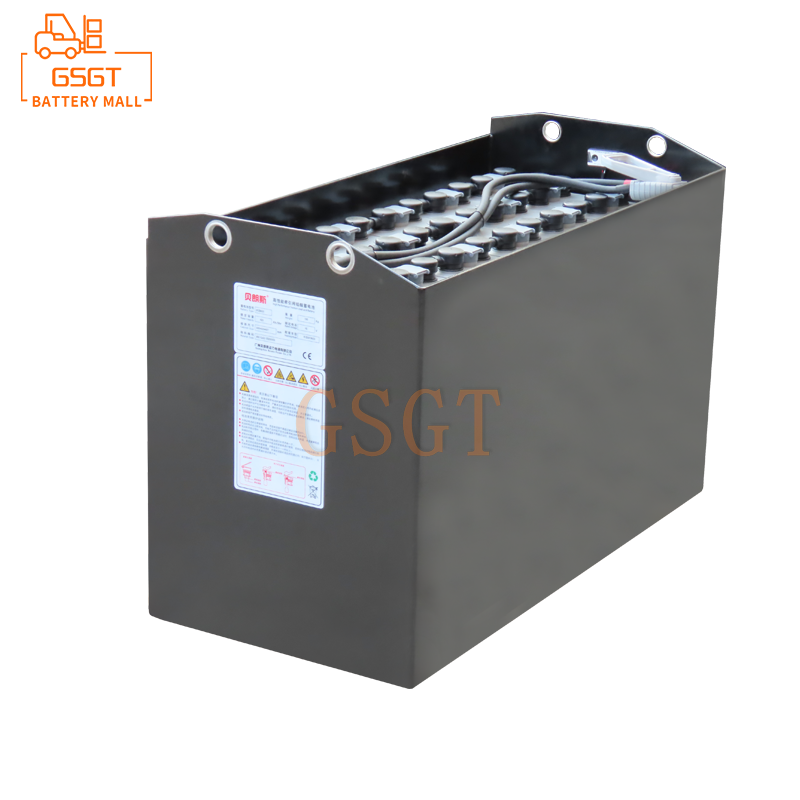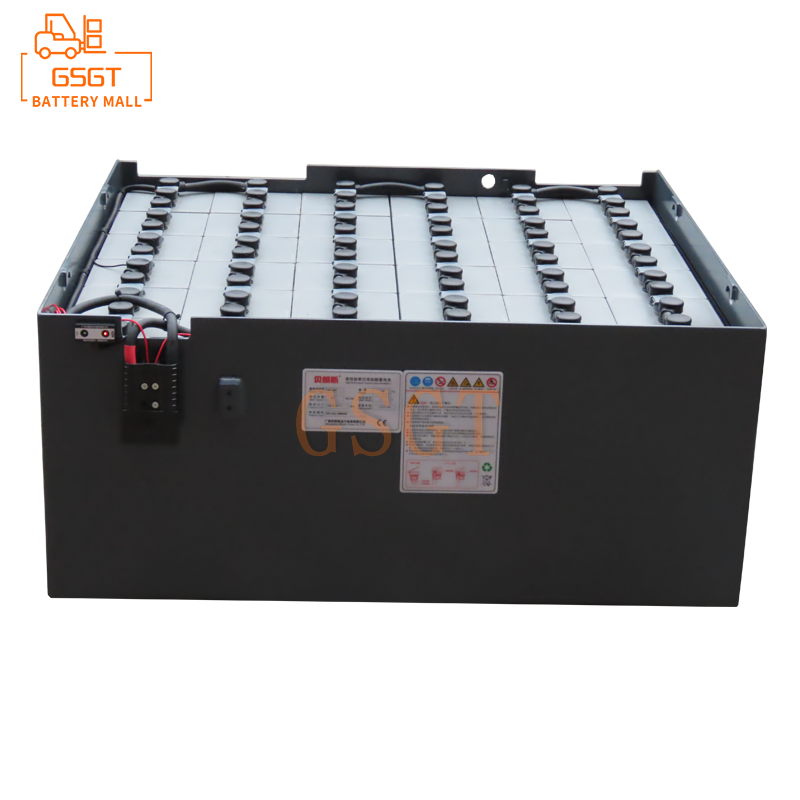Time:2025-04-08 10:26:41
Browse:600
In logistics warehousing, factory floor and other scenarios, forklifts are effective assistants for efficient handling of goods. The forklift traction lead-acid battery, as the "power heart" of forklift, its stable output is the key to ensure the smooth operation of forklift. Seemingly ordinary lead-acid batteries have many complex and exquisite principles behind achieving stable output.
1.The basic working mechanism of lead-acid batteries
The work of lead-acid batteries is based on specific electrochemical reactions. It is mainly composed of a positive plate, a negative plate, an electrolyte and a separator. When charged, electrical energy is converted into chemical energy and stored. At the positive plate, lead sulfate changes into lead dioxide through oxidation reaction by losing electrons under the action of current. The lead sulfate on the negative plate gains electrons and is reduced to spongiform lead, while the sulfuric acid concentration in the electrolyte rises. In the discharge stage, that is, when the forklift is working, the chemical energy is reversely converted into electrical energy. The active material on the positive and negative plates reacts with the electrolyte again, regenerating lead sulfate and releasing electrons to form an electric current, at which time the sulfuric acid concentration in the electrolyte decreases.
This charging and discharging cycle seems simple, but it requires the cooperation of electrode materials, electrolyte and battery structure, and any problem in any link may affect the stability of the battery output.
2. Key factors affecting stable output
(1) Plate material and structure
As the core component of lead-acid battery, the material characteristics and structural design of the plate have a decisive impact on the output stability. High-quality plate materials, such as the use of high-purity lead alloy, can effectively reduce resistance, reduce the energy loss during the charge and discharge process, so as to ensure that the current output is more stable. In terms of plate structure, the appropriate thickness, porosity and surface area are critical. Thicker plates can store more active substances, extending the service life and endurance of the battery; Reasonable porosity can make the electrolyte fully permeate and ensure the electrochemical reaction is carried out efficiently. The larger surface area increases the contact area between the active substance and the electrolyte, improves the charging and discharging efficiency of the battery, and thus maintains the stability of the output.
(2) The characteristics of the electrolyte
Electrolyte plays a key role in conducting ions in lead-acid batteries, and its concentration, purity and temperature have significant effects on the stability of battery output. The concentration of sulfuric acid in the electrolyte is directly related to the electromotive force and capacity of the battery. In general, an appropriate increase in sulfuric acid concentration can increase the initial capacity of the battery, but too high a concentration will accelerate plate corrosion, shorten battery life, and may also lead to a sharp decline in battery performance at low temperatures. The purity of the electrolyte can not be ignored, the existence of impurities will cause side reactions, reduce the efficiency of the battery charge and discharge, and even cause self-discharge phenomenon, seriously interfere with the stable output of the battery. In addition, the temperature of the electrolyte has a great impact on the battery performance. In low temperature environment, the viscosity of the electrolyte increases, the ion diffusion rate slows down, resulting in the increase of the battery internal resistance, the output voltage decreases, and the forklift is difficult to start. In the high temperature environment, although the ion diffusion speed is accelerated, the plate corrosion is intensified, and the battery water loss is serious, which will also affect the stable output and life of the battery.
(3) Battery design and manufacturing process
The overall design and manufacturing process of the battery directly determines whether it can achieve stable output. Reasonable battery structure design can ensure that the electrolyte is evenly distributed inside the battery, avoid local overheating or undercooling, and reduce the uneven corrosion of the plate. The advanced manufacturing process can ensure the uniformity of the plate paste and the tightness of the partition installation, thereby reducing the risk of short circuit inside the battery and improving the consistency and reliability of the battery. For example, the battery manufactured by the internalization process has a more uniform formation of active substances on the plate, and the initial performance and long-term stability of the battery have been effectively improved.
3. Technical means to achieve stable output
(1) Innovation of plate manufacturing technology
In order to improve the contribution of the plate to stable output, the R&D staff continue to innovate the plate manufacturing technology. In terms of materials, in addition to optimizing the lead alloy formula, new additives, such as graphene, have also been introduced. Graphene has excellent electrical conductivity and mechanical properties, added to the plate material, can enhance the conductivity of the plate, improve the adhesion of the active substance, reduce the plate in the charge and discharge process shedding phenomenon, thus significantly improving the cycle life and output stability of the battery. In the plate manufacturing process, the continuous and automatic production process can precisely control the plate thickness, porosity and other parameters to ensure the consistency of plate quality. At the same time, by improving the paste process, the distribution of active substances on the plate is more uniform, and the charge and discharge performance of the battery is further improved.
(2) electrolyte management technology
Aiming at the influence of electrolyte on the stability of battery output, a series of advanced electrolyte management technologies came into being. In terms of electrolyte concentration control, the intelligent rehydration system is used to automatically replenish distilled water or sulfuric acid by monitoring the density of the electrolyte in real time, ensuring that the electrolyte concentration is always in the best range. In order to improve the purity of the electrolyte, high precision filtration technology is used to remove impurities in the electrolyte during the battery manufacturing process. During the use of the battery, it is equipped with an ion exchange device, which can timely remove the harmful ions generated by the electrolyte in the cycle process and maintain the purity of the electrolyte. In terms of temperature management, some high-end forklift traction lead-acid batteries are equipped with liquid cooling or air cooling systems, by controlling the temperature of the electrolyte, so that it is always in the appropriate working range, effectively improving the output stability of the battery under different ambient temperatures.
(3) Application of battery management system (BMS)
The battery management system is like the "intelligent brain" of the lead-acid battery, which plays a crucial role in achieving stable output. BMS can monitor the battery's voltage, current, temperature and other parameters in real time, and accurately estimate the battery's remaining charge (SOC) and health state (SOH) through data analysis and algorithm processing. When the battery is overcharged, overdischarged, overheated and other abnormal conditions, BMS will quickly take protective measures, such as cutting off the circuit, start the heat dissipation device, etc., to avoid irreversible damage to the battery, so as to ensure the stable output and service life of the battery. In addition, BMS can also optimize the charge and discharge process of the battery according to the working state of the forklift, for example, under the high current discharge conditions such as acceleration and climbing of the forklift, the output power of the battery can be reasonably adjusted to ensure that the battery output is stable and meet the power needs of the forklift.
4. Maintenance points in practical applications
(1) Regular inspection and maintenance
In the daily use of forklift, regular inspection and maintenance of lead-acid battery is an important measure to ensure its stable output. Check whether the battery is damaged or leaking, whether the pole is corroded, and whether the electrolyte level is normal. Clean the battery surface regularly to prevent short circuit caused by dust and impurities. At the same time, deep charging and discharging of the battery at regular intervals, the so-called "activation" treatment, helps to restore part of the capacity of the battery and improve its output performance.
(2) Correct charging method
Using the correct charging method is essential to extend battery life and ensure stable output. Use a charger that matches the battery specifications, and avoid using inferior or incompatible chargers to avoid overcharging or undercharging the battery. In the charging process, it is necessary to follow the charging mode of constant current before constant voltage, strictly control the charging current and voltage, and prevent the battery from heating and water loss due to overcharging, and even cause safety accidents. In addition, try to avoid excessive battery discharge, when the battery power remaining 20%-30%, should be charged in time, excessive discharge will lead to plate vulcanization, seriously affecting the performance and life of the battery.
(3) Reasonable use environment
The use environment of lead-acid battery pulled by forklift also has a great influence on its stable output. Try to avoid using batteries in high temperature, high humidity or cold environments. In a high temperature environment, pay attention to the heat dissipation of the battery, and park the forklift in a well-ventilated place; In a cold environment, take appropriate heat preservation measures for the battery, such as installing a heat preservation cover. At the same time, it is necessary to avoid the battery working in a violent vibration or bumpy environment, prevent plate damage and electrolyte leakage, so as to ensure that the battery can stable output power.
Behind the stable output of lead-acid batteries pulled by forklifts, it involves multiple levels from basic principles to advanced technology, and then to practical application and maintenance. Only by deeply understanding these mysteries and strictly controlling all aspects of battery design, manufacturing, use and maintenance can we give full play to the performance advantages of lead-acid batteries, provide reliable power support for the efficient and stable operation of forklifts, and promote the sustainable development of logistics and industrial production.

$1105

$2450

$3810

$4045

MESSAGE
Professional And Efficient
Security
Affordable Price
Professional Services